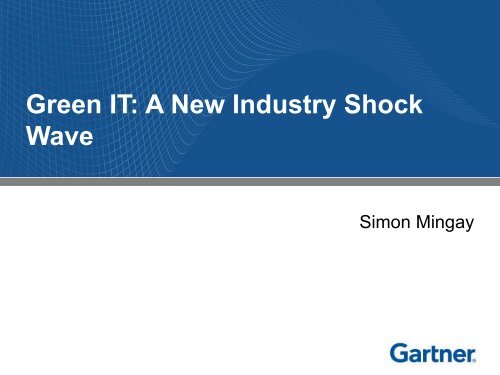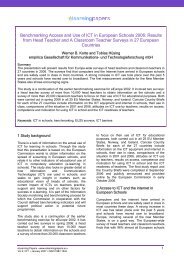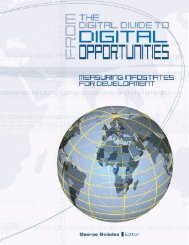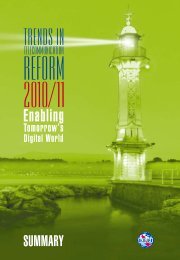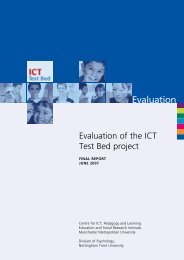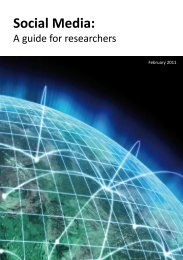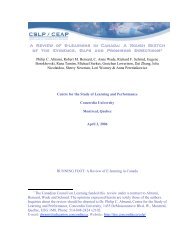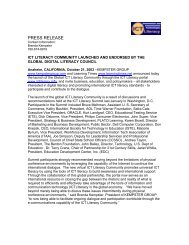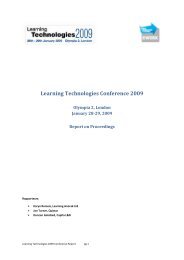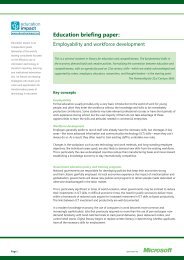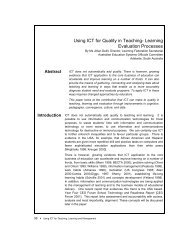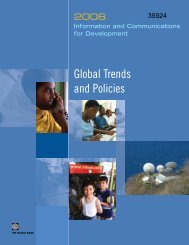Green IT: A New Industry Shock Wave - ICT Digital Literacy
Green IT: A New Industry Shock Wave - ICT Digital Literacy
Green IT: A New Industry Shock Wave - ICT Digital Literacy
Create successful ePaper yourself
Turn your PDF publications into a flip-book with our unique Google optimized e-Paper software.
<strong>Green</strong> <strong>IT</strong>: A <strong>New</strong> <strong>Industry</strong> <strong>Shock</strong><br />
<strong>Wave</strong><br />
Simon Mingay
Findings: Early Indicators of a Rising<br />
'<strong>Green</strong> Business' Trend<br />
Davos, January 2007<br />
"There will be a move away from<br />
corporate social responsibility<br />
toward long-term sustainability."<br />
Climate change voted the most important<br />
shift that will affect business, technology,<br />
society and the global economy<br />
Scott Friedheim, Co-Chief Administrative<br />
Officer, Lehman Brothers<br />
January 2007:<br />
Marks & Spencer<br />
CEO Stuart Rose<br />
committed the<br />
company to<br />
become carbonneutral<br />
and send<br />
no waste to landfill<br />
by 2012.<br />
Source: Economist EIU
<strong>IT</strong>'s Carbon Contribution<br />
The Bad <strong>New</strong>s: <strong>ICT</strong> Accounts for Approximately...<br />
2%<br />
…of Global CO 2<br />
Emissions.
But This <strong>Industry</strong> Cloud<br />
Has a Silver Lining<br />
2%<br />
The Good <strong>New</strong>s:<br />
There are substantial<br />
inefficiencies in the technology<br />
and use behaviors that can be<br />
readily addressed …<br />
…and <strong>IT</strong> can<br />
significantly<br />
contribute to control<br />
and reduce the 98%<br />
of CO 2<br />
emissions<br />
caused by other<br />
activities and<br />
industries.
What Percentage of Energy Actually Does<br />
Productive Work?<br />
Energy Source<br />
100%<br />
Generation/<br />
Distribution<br />
30%<br />
Cooling<br />
Power<br />
Supplies, UPS<br />
15%<br />
Into the Data<br />
Center<br />
99.999%<br />
Business<br />
Applications<br />
Dynamic Power<br />
1/2*C*V^2*f<br />
+ L<br />
Silicon<br />
~<br />
Into the<br />
Processor<br />
1%<br />
Into the<br />
Server<br />
~ 6%
The Effects of <strong>ICT</strong> on Environmental<br />
Sustainability<br />
1st Order<br />
(direct result of<br />
its existence)<br />
GHG<br />
Emission<br />
E-Waste<br />
Hazardous<br />
Substances<br />
Use of Scarce and<br />
Nonrenewable<br />
Resources<br />
2nd Order<br />
(from application)<br />
Travel<br />
Substitution<br />
Transportation<br />
Optimization<br />
E-Business<br />
E-Government<br />
Environmental<br />
Control Systems<br />
3rd Order<br />
(Long term socioeconomic<br />
structural<br />
changes)<br />
Energy<br />
Intensity<br />
GHG<br />
Intensity<br />
Transportation<br />
Intensity<br />
Material<br />
Intensity
<strong>ICT</strong>'s Global Carbon Dioxide Emissions<br />
LAN and Office<br />
Telecoms (7%)<br />
Printers (6%)<br />
Mobile Telecoms<br />
(9%)<br />
Fixed-Line<br />
Telecoms<br />
(15%)<br />
PCs and Monitors<br />
(39%) (excluding<br />
embodied energy)<br />
Servers,<br />
including cooling (23%)<br />
<strong>ICT</strong> accounts for approximately 2% of global CO 2<br />
emissions.
Strategic Planning Assumption<br />
By 2010, 50% of <strong>IT</strong> organizations will<br />
declare an environmental imperative<br />
(0.7 probability).<br />
By 2009, more than one-third of <strong>IT</strong><br />
organizations will have one or more<br />
environmental criteria in their top six<br />
buying criteria (0.6 probability).
Four Scenarios for the Data Center<br />
Energy Crisis<br />
SCENARIO 1 — Data Centers in Crisis<br />
Blade penetration and density increase rapidly.<br />
Efficiencies in processors, power supplies, cooling, power mgt.<br />
and DC design fail to deliver.<br />
Use behaviors don't change.<br />
Carbon prices high; tighter quotas.<br />
Power consumption continues growing rapidly.<br />
Energy costs rise. Insufficient capacity in renewables.<br />
Data center load increases.<br />
Data centers become a political and media target.<br />
SCENARIO 2 — Mid-Case<br />
Blade penetration increases gradually; blade density increases.<br />
Technology innovations and use behaviors deliver reductions in<br />
power consumption.<br />
Carbon prices rise moderately; tighter quotas.<br />
Power consumption and CO2 emissions stable.<br />
Energy costs rise slightly. Renewables help.<br />
Data center load increases slightly.<br />
SCENARIO 3 — Best Case 1<br />
Blade penetration and density increase slowly.<br />
Use behaviors and technology innovations deliver reductions in<br />
power consumption.<br />
Carbon prices rise moderately; quotas tolerable.<br />
Power consumption and CO2 emissions fall.<br />
Energy costs rise slightly. Renewables help.<br />
Data center load falls.<br />
SCENARIO 4 — Best Case 2<br />
Blade penetration and density increase rapidly.<br />
Technology innovations and use behaviors deliver substantial<br />
reductions.<br />
Carbon prices high; quotas tolerable.<br />
Power consumption and CO2 emissions fall.<br />
Energy costs rise slightly. Renewable capacity available.<br />
Data center load rises.<br />
<strong>ICT</strong> seen as critical to combat climate change.
Four Scenarios for the Data Center<br />
Energy Crisis<br />
SCENARIO 1 — Data Centers in Crisis<br />
" Blade penetration and density increases rapidly.<br />
" Efficiencies in processors, power supplies, cooling,<br />
power mgt. & DC design fail to deliver.<br />
" Use behaviors don't change.<br />
" Carbon prices high; tighter quotas.<br />
" Power consumption continues growing rapidly.<br />
" Energy costs rise. Insufficient capacity in<br />
renewables.<br />
" Data center load increases.<br />
" Data centers become a political and media target
Four Scenarios for the Data Center<br />
Energy Crisis<br />
SCENARIO 4 — Best Case 2<br />
" Blade penetration and density increase rapidly.<br />
" Technology innovations and use behaviors deliver<br />
substantial reductions.<br />
" Carbon prices high; quotas tolerable.<br />
" Power consumption and CO2 emissions fall.<br />
" Energy costs rise slightly. Renewable capacity<br />
available.<br />
" Data center load rises.<br />
" <strong>ICT</strong> seen as critical to combat climate change.
Action #1: Define a Policy and Strategy<br />
for First- and Second-Order Effects<br />
• Identify the enterprise's position on climate change,<br />
e-waste and the environment — act as a catalyst, if<br />
necessary.<br />
• Conduct a risk assessment of doing nothing.<br />
• Decide whether the enterprise is going to be<br />
aggressive, measured or passive in its response and<br />
to which issues.<br />
• Develop a strategy to reduce power consumption<br />
and CO 2<br />
emissions in the data center, client<br />
computing, network, printing and so forth.<br />
• Create an environmental assessment process for all<br />
<strong>ICT</strong>-related investments.<br />
• Create an equipment disposition process and<br />
controls.<br />
• Strategize to identify the second-order effect<br />
opportunities within the enterprise.<br />
• Appoint a manager to take oversight.
Action #2: Measure Data Center Energy<br />
Efficiency, Reward the Right Behaviors<br />
Potential Range<br />
Avg.<br />
Power Usage<br />
Effectiveness<br />
(PUE) 2<br />
Total Data Center Electricity Consumption<br />
Electricity Consumption by <strong>ICT</strong> Equipment<br />
3 — 1.35 1<br />
2.0 — 2.4<br />
Data Center<br />
Efficiency<br />
(DCiE) 2<br />
Electricity Consumption by <strong>ICT</strong> Equipment<br />
Total Data Center Electricity Consumption<br />
0.33 — 0.74 1<br />
0.42 — 0.50<br />
Real DC<br />
Efficiency<br />
Electricity Consumption by <strong>ICT</strong> Equipment<br />
Electricity Consumption Doing Useful Work<br />
???<br />
<strong>ICT</strong><br />
Equipment<br />
Cooling, Power, Generation,<br />
Electrical Equipment<br />
Support Services<br />
Energy (kWh)<br />
Water (gallons/<br />
liters)<br />
Data (?)<br />
Data Center<br />
1) <strong>Green</strong>berg, S., E. Mills, and others (2006). "Best Practices for Data Centers: Results from Benchmarking 22 Data Centers." Proceedings of<br />
the 2006 ACEEE Summer Study on Energy Efficiency in Buildings. (http://eetd.lbl.gov/emills/PUBS/PDF/ACEEE-datacenters.pdf), Rocky<br />
Mountain Institute High Performance Data Center, 2004<br />
2) www.thegreengrid.org and others<br />
Heat<br />
Water<br />
Waste (electrical, electronic,<br />
emissions to air) tons<br />
Services and Data (?)
Why Care About Energy Efficiency In the<br />
Data Center?<br />
Operational Energy Costs (€) per Watt<br />
Over 3 yrs<br />
Energy Costs (000's € ) for 1,000 servers Over<br />
3 yrs @ 350W/server<br />
Euro(€)<br />
10.00<br />
8.00<br />
6.00<br />
4.00<br />
2.00<br />
0.00<br />
3.97<br />
6.34<br />
8.64<br />
Europe (€)<br />
€/Watt<br />
5.41<br />
2.44<br />
000's €<br />
4,000<br />
3,000<br />
2,000<br />
1,000<br />
0<br />
1,390<br />
2,217<br />
3,024<br />
Europe (€)<br />
1,895<br />
853<br />
a b c d e<br />
a b c d e<br />
a. €0.686/kWh, PUE 2.2<br />
b. €0.1095/kWh, PUE 2.2<br />
c. €0.1095/kWh, PUE 3<br />
d. €0.686/kWh, PUE 3<br />
e. €0.686/kWh, PUE 1.35<br />
CO2 Footprint (000's kg ) For 1,000 Servers<br />
Over 3 yrs @ 350W/server<br />
Just Imagine How Good It Would Be If You Reduced the Load as Well!<br />
CO2 (kg)<br />
18,000<br />
15,000<br />
12,000<br />
9,000<br />
6,000<br />
3,000<br />
0<br />
12,150<br />
16,568<br />
CO2 (kg)<br />
a d e<br />
7,455
Strategic Planning Assumption<br />
By 2010, two-thirds of best-practice<br />
enterprises will achieve a 25% reduction<br />
in <strong>ICT</strong>-related power consumption<br />
compared with 2007 levels for the same<br />
workload, simply by changing the<br />
behaviors associated with client devices<br />
and in the data center.
Action #3: Consider Energy at Every Decision<br />
Level — Use the <strong>ICT</strong> Energy Stack<br />
Energy Efficiency Application of <strong>ICT</strong> (e.g., videoconferencing, SCM)<br />
Delivery Model (e.g., SaaS, shared service)<br />
Workload From the Business<br />
Technology Architecture, Design and Engineering<br />
Application Design and Software Engineering<br />
Infrastructure, Ops & Energy Management Processes &Tools<br />
Client Devices (including OS)<br />
Application Components & Middleware (e.g., Grid, Virtualization)<br />
Servers (including OS) and Storage<br />
Network<br />
Data Center Cooling<br />
Data Center Power Infrastructure (PDUs, UPS)<br />
Building (construction, energy efficiency, reuse of heat, etc.)<br />
Physical Location<br />
Energy Sources (renewables, CHP, local, etc.)<br />
Integrated Goals, Objectives, Governance
Action #4: Take a Holistic Approach to<br />
Reducing <strong>IT</strong>, Cooling and Power Loads<br />
Cooling Efficiency Is a Big Opportunity<br />
• Must be made smarter, more dynamic.<br />
• Check airflows around the data center.<br />
• Conduct a CFD analysis.<br />
• Investigate local options for free cooling<br />
— look at air-side and water-side<br />
economizers.<br />
• Bottom-to-top airflow.<br />
• Use cold-aisle/hot-aisle rack<br />
configuration.<br />
• Maintain static pressure at 5% above<br />
room pressure.<br />
• Avoid air leaks in raised floor.<br />
• Use blanking panels.<br />
• Plumb new builds for liquid cooling.<br />
• Investigate local power generation.<br />
(combined heat and power particularly)<br />
Reduce Power<br />
Distribution Losses<br />
UPS, power supplies, DC vs. AC,<br />
distributed (local) generation (CHP, solar,<br />
etc.), renewables<br />
Reduce Cooling Load<br />
CFD Analysis, air flow improvements, free<br />
cooling, layout (hot /cold aisles)<br />
Reduce <strong>IT</strong> Load<br />
Consolidate, virtualize, decommission,<br />
dynamic power load management, power<br />
management, right size, efficient servers,<br />
architectural/software choices, etc.<br />
Reduce the Overprovisioning
Consolidate, Virtualize and<br />
Decommission in the Data Center<br />
2007 2008-2012<br />
2010-2016<br />
Policies<br />
Optimization<br />
" Hardware<br />
Costs Down<br />
" Energy<br />
Efficiency up<br />
" Flexibility up<br />
" Service<br />
Levels and<br />
Service<br />
Agility up<br />
Provisioning<br />
Workloads<br />
Data<br />
Resources<br />
Identities<br />
Services<br />
Availability<br />
Virtualize<br />
and<br />
Decommission
Begin the Journey From Always on, to<br />
Always Available<br />
The Data Center Problem<br />
• Everyone is working on power efficiency, but a technology<br />
"fix" is more than three years away for most enterprises.<br />
• "If it ain't broke, don't touch it" — Well, it's broke now.<br />
• Energy management and cooling are very static.<br />
The Opportunity<br />
• Low server utilization.<br />
• The technology exists to reduce power consumption.<br />
The Fix<br />
• Virtualize.<br />
• Stop overprovisioning (servers, UPS and cooling).<br />
• Use power management features to throttle power based on<br />
use.<br />
• Use a low power state or shut servers down when not in use.<br />
• Use management software to automate changing the power<br />
status of equipment.
A Vision for the Dynamic, Integrated <strong>ICT</strong><br />
Energy Management Architecture<br />
Energy Policies and Event Correlation<br />
Real-Time<br />
Energy<br />
Monitoring<br />
Energy Is Just Another Resource That Needs<br />
Managing<br />
Applications<br />
Application Components<br />
Middleware Portals Virtualization<br />
Servers/OS<br />
Storage<br />
Services<br />
Network<br />
s<br />
Grids<br />
Enterprise and Ops. Mgmt. Tools<br />
Job Schedulers<br />
Chargeback<br />
Tools<br />
Global Infrastructure Components<br />
BSM<br />
Energy Monitoring<br />
Event Mgmt.<br />
Clients/OS Power Infra.<br />
Databases Cooling<br />
Configuration Mgmt.<br />
Performance<br />
Mgmt.<br />
Hardware<br />
Energy<br />
Mgmt.<br />
Microprocessor<br />
s<br />
Chip Sets
Power Supplies and Distribution<br />
Inefficiencies and Energy Waste<br />
Grid supplies and facilities<br />
Need improvements in building<br />
and facilities<br />
Distribution and management of<br />
energy<br />
Use of more-efficient<br />
Generators<br />
Beware of efficiency vs.<br />
reliability<br />
AC vs. DC<br />
Efficiency vs. usage<br />
Safety of high-voltage systems<br />
UPS * PDU units<br />
Need to improve efficiency<br />
Rotary and cell<br />
Better power monitoring<br />
CHP<br />
Adoption of combined units<br />
improves usage<br />
Use of economizers (lower<br />
operating temperatures)<br />
Computer<br />
More-efficient power supplies<br />
Multiple vs. single supply<br />
Availability vs. energy use<br />
Focus on fans/blowers<br />
Idle power usage vs.<br />
peak<br />
Technology, patents<br />
Electrical conversion at the<br />
server<br />
Use of multiple paths<br />
Processors<br />
Dynamic power vs.<br />
leakage<br />
Horizontal scaling, cores<br />
Silicon<br />
Energy management<br />
software<br />
Use of server<br />
management tools<br />
External tools
Action #5: Live Life on the Edge; Dare to<br />
Switch Some of It OFF When Not in Use!<br />
The Opportunity<br />
• PCs, monitors account for more than a third of <strong>ICT</strong><br />
power consumption and CO 2<br />
emissions<br />
• Nine percent to 15% of office power is consumed<br />
by office equipment (PCs and monitors)<br />
• Sixty percent of PCs are left on after hours<br />
The Fix (mostly behavioral)<br />
• Measure and report office power consumption —<br />
get granular.<br />
• Use and enforce "aggressive" power<br />
management.<br />
• Ditch the active screen savers.<br />
• Educate staff.<br />
• Use a low-power state, such as standby, for PCs<br />
and monitors after hours.<br />
• Use agents and schedulers to automate.
Action #6: <strong>Green</strong>ing Printers and Printing<br />
The Opportunity<br />
• The paper itself consumes 10x the energy of printing on it.<br />
• 178 million printers, copiers and MFDs shipped in 2007.<br />
• Average office worker prints 1,000 pages/month, 40<br />
lbs/month.<br />
• Too many printers on desks; too many models.<br />
The Fix (mostly behavioral)<br />
• Print less — measure and Analyze document flows<br />
• Educate staff — why this makes a difference.<br />
• Enforce duplex printing (explain why).<br />
• Use pull printing and drop the banner page.<br />
• Buy Energy Star devices.<br />
• Consolidate printers into fewer, standard, low -impact, better<br />
MFDs that share the same consumables.<br />
• Use long-life drums. Check remanufactured quality and<br />
recycling.<br />
• Recycle — paper, toner cartridges.<br />
• Dispose of used drums and printers appropriately.
Action #7: <strong>Green</strong>ing the Staff (a Case Study):<br />
'It's Mostly a Behavioral Challenge!'<br />
• The employee charter<br />
- Why this is important for all stakeholders<br />
- Lays out employee's personal responsibilities<br />
- What behaviors are expected<br />
- Services the company will provide<br />
• Regularly communicate the enterprise environmental goals,<br />
footprint and progress through multiple channels<br />
• Create a work environment that includes subtle reminders<br />
- Remove deskside bins; provide recycling points<br />
- Offer recycling for domestic waste, such as WEEE<br />
- Car share/carpool<br />
• Points and reward schemes for walking, cycling, using public<br />
transport, train vs. plane<br />
• Energy-efficiency advice and assistance for home workers<br />
• Financial assistance for purchase of hybrid/electric cars
What Does the Future Hold?<br />
• Carbon cap and trading, increasing costs of energy.<br />
• Increased legislation, regulation and tax breaks — power consumption,<br />
hazardous substances and e-waste.<br />
• Broader-based and more-demanding energy-rating and eco-labeling<br />
schemes, such as Energy Star for servers, Energy Star 4, EPEAT Gold.<br />
• Energy management across the <strong>ICT</strong> infrastructure, creating a more<br />
dynamic sense-and-respond environment.<br />
• More-efficient and smarter cooling, UPS and power supplies in the data<br />
center and for client devices and so on.<br />
• Improved screen technology — more power-efficient and mercury-free.<br />
• Better power management at every level — processors, PCBs, systems,<br />
operating systems and applications.<br />
• Power consumption as a design criterion for software and energy<br />
profiling.<br />
• Limited materials innovation until there's a commercial driver.<br />
• A biodegradable, non-toxic PC — probably not, but certainly massive<br />
improvements.
Recommendations —<br />
It Starts With Measuring<br />
Reduce<br />
Consume fewer servers, printers and so forth by<br />
increasing utilization — virtualize.<br />
Stop overprovisioning; improve capacity planning.<br />
Turn equipment off, turn power management on.<br />
Print less.<br />
Reuse<br />
Extend the life of assets by reusing them within the<br />
enterprise and externally.<br />
Use recycled paper.<br />
Recycle<br />
Ensure and validate the correct disposition of ALL<br />
electronic equipment.<br />
Analyze all waste.<br />
Buy recyclable products.
<strong>Green</strong> <strong>IT</strong>: A <strong>New</strong> <strong>Industry</strong> <strong>Shock</strong><br />
<strong>Wave</strong><br />
Simon Mingay
<strong>Green</strong> <strong>IT</strong>: A <strong>New</strong> <strong>Industry</strong> <strong>Shock</strong><br />
<strong>Wave</strong><br />
Simon Mingay


